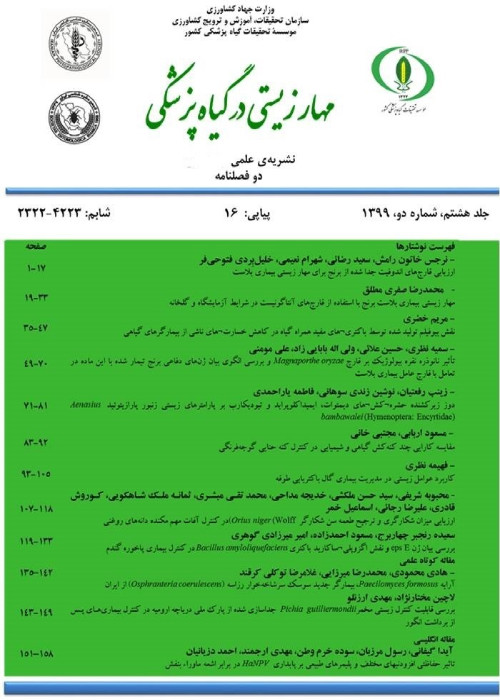The infected of tomato leafminer moth (Tuta absoluta) by native isolate of Heterorhabditis bacteriophora
Author(s):
Abstract:
Entomopathogenic nematodes are obligatory parasites of insects, which are used in many integrated pest management programs. The effect of a native isolate of Heterorhabditis bacteriophora on different larval instars of tomato leafminer Tuta absoluta were evaluated under Invitro and Invivo conditions. The isolates of H. bacteriophora were collected from the soil of alfaalfa fields located in Firoozkouh area by using last instars larvae of wax moth, Galleria mellonella, by baiting technique. The isolated nematode was reared on the last larval instars of G. mellonella to produce sufficient population of the nematode (Fig.1- A). The tomato plants infected by T. absoluta were collected from greenhouses under tomato cultivation in Varamin, and different larval instars pest were also obtained from the same locations. In Invitro experiment, 10 different larval instars of tomato leafminer were placed individually in a Petri dish. About 1000 third stage infective juveniles (IJs) were added to each Petri dish and preserved at laboratory conditions. In addition, a control treatment was considered without entomopathogenic nematodes. The results showed that H. bacteriophora infected all the larval stages of Tuta within 48 hours and caused 100% mortality. Infected larvae were inactive and accumulation of the nematodes on the surface of larval body was visible after 72 hours. IJs of nematode and females and males were gradually appeared (Fig. 1- B). InInvivo experiment, adult leafminer were released on tomato seedlings, after establishment of pest on tomato leaves and observation the egg lying and larval instars, the seedlings were sprayed with 2×103 IJs/ lit of water every alternative day for 4 days. Infected tomato seedlings by Tuta was checked as control and sprayed with water. 96 hours after spraying the leafminer larvae were collecteded from leaves and transferred to Petri dishes and incubated by using White method (White, 1927). The infected larvae of Tuta showed the presence of nematodes on their body surface after 72 hours. The results of Invivo experiments showed that the infective juveniles of H. bacteriophora were capable of penetrating the parenchymal tissues channels made by Tuta and caused 100% infection and mortality of the leafminer larvae. This to our knowledge is the first report of the parasitism of the tomato leafminer by H. bacteriophora in Iran. We suggest complementary research studies on this nematode and its host.
Keywords:
Language:
Persian
Published:
BioControl in Plant Protection, Volume:2 Issue: 2, 2015
Pages:
75 to 77
magiran.com/p1468563
دانلود و مطالعه متن این مقاله با یکی از روشهای زیر امکان پذیر است:
اشتراک شخصی
با عضویت و پرداخت آنلاین حق اشتراک یکساله به مبلغ 1,390,000ريال میتوانید 70 عنوان مطلب دانلود کنید!
اشتراک سازمانی
به کتابخانه دانشگاه یا محل کار خود پیشنهاد کنید تا اشتراک سازمانی این پایگاه را برای دسترسی نامحدود همه کاربران به متن مطالب تهیه نمایند!
توجه!
- حق عضویت دریافتی صرف حمایت از نشریات عضو و نگهداری، تکمیل و توسعه مگیران میشود.
- پرداخت حق اشتراک و دانلود مقالات اجازه بازنشر آن در سایر رسانههای چاپی و دیجیتال را به کاربر نمیدهد.
In order to view content subscription is required
Personal subscription
Subscribe magiran.com for 70 € euros via PayPal and download 70 articles during a year.
Organization subscription
Please contact us to subscribe your university or library for unlimited access!


